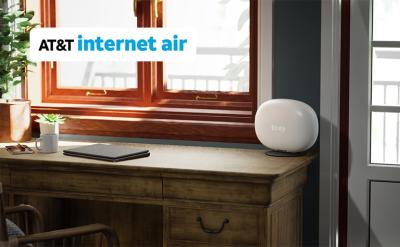Remember that negative vibe that AT&T executives gave about fixed wireless access (FWA) over the past few years or so? That appears to have turned a lot more positive.
AT&T announced today that its new fixed wireless home internet service, dubbed Internet Air, is now available in more than a dozen markets across the U.S.
The emphasis here is on the customer installation process, which AT&T says can be done in five easy steps, with the customer up and running in less than 15 minutes. The operator is not disclosing the manufacturer of the hardware that customers install in their homes.
Both T-Mobile and Verizon are aggressively targeting FWA with their own home internet products and discovering it’s one of the few 5G success stories. But AT&T was the odd one out, showing little interest until earlier this year, when CEO John Stankey mentioned it during an earnings call.
According to a new blog post, AT&T’s team over the past year has been working hard to identify customer pain points and created a solution by using available network capacity in areas that are less densely populated while still providing a strong connection. “Thus, AT&T Internet Air was born,” wrote Erin Scarborough, president of Broadband and Connectivity Initiatives at AT&T, in the blog.
AT&T already rolled out AT&T Internet Air to existing copper-based customers “with great success,” she noted. They’re now focused on locations with enough wireless coverage and capacity to deliver “not only a great in-home experience, but also maintain a top-notch wireless service for our existing mobile users.”
Fiber still No. 1, but …
In a statement provided to Fierce, Scarborough explained that “nothing has changed” about its strategy.
The company still believes that fiber is best and will continue to expand its fiber footprint. It’s the best fixed option where it is readily available and economically feasible, she said.

However, fiber is also capital intensive and takes a long time to build. “Our goal is to make fiber available as broadly as possible. Until then, in areas where fiber is not yet available or feasible, AT&T Internet Air is a viable solution that can deliver reliable connectivity to communities across the country. It’s a great bridge to the future,” she said.
AT&T Internet Air also will help facilitate transitioning AT&T’s customers from copper-based and other legacy internet services to a better experience through newer technologies like wireless and fiber, which is where they’re investing, according to AT&T.
In the blog post, Scarborough didn’t disclose exactly which spectrum bands will be used for the FWA service. In answer to emailed questions from Fierce, she said if a customer is in a 5G footprint, they will receive it over 5G. If not, it will be LTE. AT&T also made clear that it is not a millimeter wave product. However, it can use C-band spectrum where available.
The installation process
Apparently the secret sauce is the ease with which it can be installed. Other carriers have tried to streamline this over the years and usually say they solved the puzzle. AT&T appears to be saying the same.
One of the biggest pain points for these FWA products is the very high return rate, noted Recon Analytics founder Roger Entner. People love that they can go into a store, pick up a box and try it. Within 15 minutes, they can know if it works or not. If it doesn’t work, they take it back to the store, and that can be up to 20% of the time, he said.
The problem is, people tend to put the FWA router in the same place their fixed router was, usually somewhere in the middle of the home. “That’s the worst place for a wireless router,” which tends to be better near a window, he said, adding that with AT&T’s app, they’ve perfected the process with a speed test that runs on the spot. If it’s good, they’re all set. If it’s not good, it suggests moving to a different spot. “That is the difference and the nifty innovation,” he said.
According to AT&T’s description of the process, upon opening the Internet Air box, customers will scan a QR code to access a step-by-step guide providing instructions. The AT&T Smart Home Manager app “makes set-up fool-proof with the use of a unique feature that helps you find the best spot in your home with the strongest connection,” Scarborough explained. “We also offer add-on Wi-Fi extenders to create a whole-home mesh Wi-Fi eliminating dead zones.”
AT&T Internet Air’s new footprint includes the following: areas of Los Angeles, CA; Philadelphia, PA: Cincinnati, OH; Harrisburg-Lancaster-Lebanon, PA; Pittsburgh, PA; Las Vegas, NV; Phoenix (Prescott), AZ; Chicago, IL; Detroit, MI; Flint-Saginaw-Bay City, MI; Hartford-New Haven, CT; Minneapolis-St. Paul, MN; Portland, OR; Salt Lake City, UT; Seattle-Tacoma, WA; and Tampa-St. Petersburg (Sarasota), FL.
The company said it will offer one plan, which sells for $55 a month plus taxes. It promises no price increase at 12 months, no equipment fees, no overage fees and no annual contract. Internet Air is also eligible for the Affordable Connectivity Program (ACP) for eligible households with a benefit of up to $30 a month to reduce the cost of broadband service.
